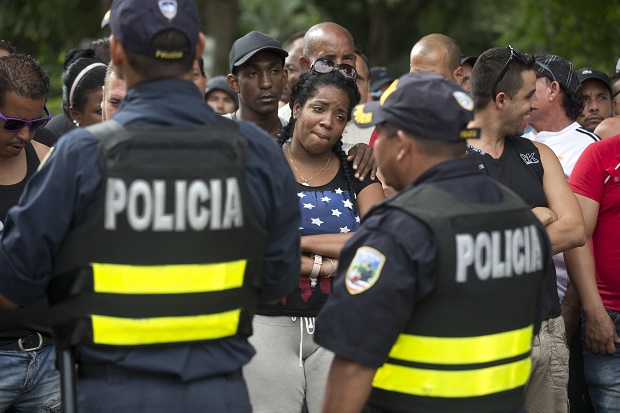
Cuban migrants take part in a protest blocking the Pan-American Highway, demanding access to Nicaragua, in Peñas Blancas, Costa Rica, Tuesday, Nov. 17, 2015. More than 1,000 Cuban migrants heading north to the United States tried to cross the border from Costa Rica into Nicaragua, causing tensions to soar between the neighbors as security forces sought to turn them back. Nicaragua’s government responded furiously on Sunday with a statement saying that Costa Rica “had deliberately and irresponsibly thrown, and continues to throw” the Cuban migrants into its territory, violating its national sovereignty. AP
HAVANA — Cuban officials blamed the United States late Tuesday for instigating a surge in the number of Cuban migrants attempting to reach the US through Central America amid ongoing efforts to normalize relations between the former Cold War foes.
In a statement aired on the government’s nightly broadcast, Cuba’s Ministry of Foreign Relations said US policy allowing nearly all Cuban migrants who reach US soil to stay contradicts ongoing efforts to renew relations between the countries.
“This policy encourages illegal emigration from Cuba to the United States and constitutes a violation of the letter and spirit of the migration accords,” the statement read.
The statement marked Cuba’s first official response to the swell of migrants fleeing the island since Presidents Barack Obama and Raul Castro announced plans to restore diplomatic ties nearly one year ago.
The situation intensified Sunday when Nicaraguan troops forcefully pushed Cuban migrants trying to cross the border en route to the United States back into neighboring Costa Rica.
Costa Rican Foreign Minister Manuel Gonzalez said in a radio interview Tuesday that there are nearly 2,000 people currently at the border being blocked by Nicaraguan soldiers from entering the country. He proposed the creation of a “humanitarian corridor” for Cubans transiting Central America.
“We have to do something with them, give them a solution,” Gonzalez said. “They want to continue. Even though a government sends the army after a peaceful migrant population, they are going to find a way to go.”
More than 45,000 Cubans arrived at US checkpoints along the border between Texas and Mexico in the fiscal year that ended in September. Many migrants from the island fear that the reestablishment of diplomatic ties between Washington and Havana may bring an end to the “wet-foot, dry foot” policy permitting most Cuban migrants to stay.
READ: Castro, Pena Nieto seal warmer Cuba-Mexico ties
Those who flee Cuba on raft and are caught by the US Coast Guard at sea are usually returned.
US officials have stated they do not have any intention of changing current immigration policy toward Cuba. The US and Cuba have held regular meetings on migration accords since the 1990s.
Cuban officials have repeatedly asked that Washington rescind the “wet-foot, dry foot” policy, saying it encourages Cubans to attempt perilous trips that have claimed an untold number of lives.
Dagoberto Fernandez, a Cuban mechanic traveling with his pregnant wife, said they began their journey from Ecuador and had no problems until now.
“Everyone that we have encountered since leaving Ecuador is behaving well. The problem began upon arriving at the border with Nicaragua,” Fernandez said.
“We don’t want to stay. We don’t want problems,” he said. “We’re a group of human beings trying to achieve their dream: arrive in the United States.”
Costa Rica announced Friday that it was issuing special seven-day transit visas for Cuban migrants. The proposed humanitarian corridor would seek to protect their rights as they travel north through Central America.
Ecuador does not require Cubans to obtain visas, so many begin their journey there.
Immigration authorities in Costa Rica say another group of 1,500 Cubans who crossed into the country Saturday from Panama are making their way north.
About 300 Cubans are expected to arrive at Costa Rica’s southern border each day.
Before Cuban officials released their statement, a group of about a dozen young adults gathered on a busy Havana intersection to demand the government address the situation early Tuesday evening.
“Many people don’t have any idea what is going on,” said Taylor Torres, 30, a blogger who said he found out about the swell of Cubans pushed away from the Nicaraguan border only after reading a story on the Internet, which many Cubans do not have access to.
Taylor and others convened after word spread online calling for “flashmob without borders” via social media. Such spontaneous gatherings are highly unusual in Cuba.
The demonstration quickly dispersed after it began to rain.

